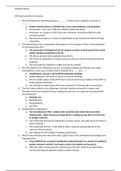Tentamen (uitwerkingen)
Global Political Economy 72 exam questions and answers
- Instelling
- Vrije Universiteit Amsterdam (VU)
In this file you will find the most common GPE exam question and answers 71 MC questions + answers and one open question
[Meer zien]





